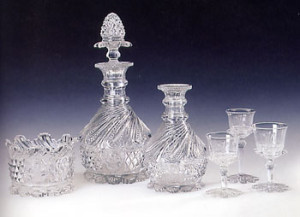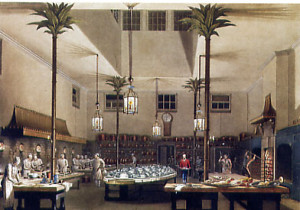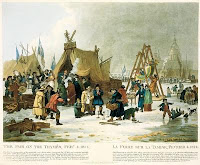I have a fun book from Royal Collection Publications called For the Royal Table, Dining at the Palace. I wouldn’t actually classify this as a research book, as it skims through the history of entertaining by England’s monarchs with a focus on Elizabeth II. No index to speak of, but lots of great pictures and some fun tidbits from dinners held by past monarchs.
For example, in discussing glassware, it mentions that

Glassware ordered by George IV – 1808
In 1802 Frederick, Duke of York (second son of George III) ordered a complete glass service for a dessert course from the chandelier manufacturers Hancock, Shepherd & Rixon. This was intended for a banquet to entertain Tsar Alexander I of Russia. It was not only a service of drinking glasses; it included elaborate candelabra, known as lustres, and dessert stands for displaying fruit. Glass was considered an elegant alternative to porcelain for showing off the dessert course.

Carême in the kitchen – Brighton Pavilion
Antonin Carême, the only French chef to work for the royal family, is well represented. Although Carême remained in England only six months, he was busy.
He invented dishes such as Pike à la Régence – a pike stuffed with quenelles of smelt and crayfish butter, and dressed with truffles, crayfish tails, sole fillets and bacon and garnished with truffles, slices of eel, mushrooms, crayfish tails, oysters, smelts, carp roes and tongues and 10 garnished skewers of sole, crayfish and truffles. Just a light lunch for Prinny.

Banqueting Table – George IV Coronation
Carême was also big on food as decoration. He decorated the table with structures resembling architectural follies and ruins, using any material available – from icing sugar and confectioner’s paste to cardboard, wood, glass, silk, sugar, powdered marble, way and coloured butter. Not something you’d want for dessert.
He was around long enough to produce an over-the-top banqueting table for George IV’s coronation.
The accounts for the decoration of the banqueting table… include a detailed carpenters bill for a large ornamental temple for the table with eight reeded columns and four circular pedestals for figures at the angles, with four entablatures over to support a dome. The wooden structure would have been decorated with sugar and marzipan and further edible items. Indeed, after the King had left the banqueting table, the guests destroyed all the edible parts of the decoration in their desire to keep a souvenir of the event.
And speaking of desserts, they weren’t too puny before Carême arrive. Newspapers described the the dessert course of a banquet held for George III at Windsor thus:
The ornamental parts of the confectionery were numerous and splendid. There were temples four feet high, in with the different stories were sweetmeats. The various orders of architecture were also done with inimitable taste… the dessert comprehended all the hothouse was competent to afford — and, indeed, more than it was thought art could produce at this time of year. There were a profusion of pine[apples], strawberries of every denomination, peaches, nectarines, apricots, cherries of each kind, from the Kentish to the Morella, plus and raspberries with the best and richest preserved fruits, as well as those that are in syrup.
Voila! Dessert! Sort of makes your strawberry shortcake look pretty paltry, doesn’t it?
This is a fun book with interesting tidbits, but not something you absolutely need in your reference library. Heaven knows why I have it.
What would you recommend for food references for our period?




